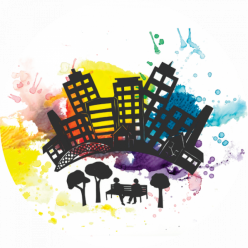“I’m really fascinated by what art does and can do in the world…there’s a magic in it.”
Chris Sinding
In our in conversation with … series of posts we introduce you to the people behind the Transforming Stories, Driving Change project—the artists, researchers, and community participants who desire Transforming Stories to make a substantive contribution to civic engagement in the city of Hamilton. Chris Sinding is co-Principal Investigator on Transforming Stories, Driving Change and a Professor and Director of the School of Social Work at McMaster University.
What is your role on the Transforming Stories, Driving Change project Chris?
In the life of the project I feel my role is learner, observer, wonder-er… I’m really fascinated by what art does and can do in the world, and I bring that question to our big-picture conversations and also to the details of the workshops – to the image theatre exercises that my colleagues facilitate, for example.
I suppose too that, with some of the collaborators on the project, I hold down the social science end of the interdisciplinary spectrum of people involved in the project and thinking about what it all means. And then more specifically I have a role in considering how social work contributes to and can draw from what we discover together.
How did you get involved with Transforming Stories?
Many years ago, when I was a PhD student I was involved in (what we called at the time) a research-based drama project. The research part involved focus groups and individual interviews with women who had advanced breast cancer. The research team got together with a theatre director at Ryerson, and her troupe of amateur actors, and two women with advanced breast cancer, to create a drama, working from those interview transcripts.
And it had magic in it. It did things to us and to audiences that more conventional qualitative research rarely does. That’s not to diss conventional research… it just does different things.
I have done lots of qualitative research in cancer care over the past several years. And then more recently, I’ve started finding my way backwards and forwards, to arts-informed explorations and presentations.
What are your hopes for the project?
It’s partly about understanding the magic…! What does art do… and how does it do what it does?
As we reviewed the literature on arts-informed social work, the question we asked, over and over, was: what do the authors think art is ‘doing’ here? What is art achieving for service users or practitioners or student or researchers or communities – what is it achieving for relationships or for ideas about the social world… and especially what is art doing that that usual social work education or practice or research – does not do – or does not do as well?
In my readings on what art can do, three themes stand out. Art offers an alternative way for people to express themselves in situations where language or conventional or dominant language is ill-suited for what needs expressing, inadequate or constraining or exclusionary…
Art allows us to imaginatively enter the situation of another … The idea here is that when we engage with art about people and communities unfamiliar to us, we are able to participate vicariously in their worlds; our senses are activated; we respond emotionally as well as intellectually; we come to ‘know’ the other in ways we would not in a more conventional account. The classic metaphor here is that art enable us to walk in another’s shoes.
The third theme rests on the idea that dominant images (media images, stereotypes more broadly), inculcated into our ways knowing, become perceptual habits… habits of knowing that diminish others. The idea here is that artful images, especially as they are in compelling ways set against or in their contrast with dominant images – can interrupt our usual ways of understanding and knowing – art can ‘break bad habits’ of knowing.
There are all kinds of complexities and potential problems with these ideas as well… for example, what happens to someone else when we ‘walk in their shoes’ – might their shoes become damaged in some way? And if art is so good at ‘getting stuff out’ – might people who engage with art ‘say more’ than they might have wished?
So it’s not simple, the ethics of it are not simple. Now that I’m involved much more closely with scholars and practitioners from other disciplines, my ideas about what art does and can do are widening…
What can Transforming Stories, Driving Change contribute to the social sciences?
TSDC is concerned with the conversation happening in Hamilton about the future of the City, about life in this community, about what’s good for us as a community. We know that many people are excluded from this conversation, not because they have nothing to say, but because only certain speakers as recognized as legitimate — and only certain ways of speaking are heard or recognized as worthy contributions to the conversation.
This project tries to interrupt the value patterns that fail to recognize the contributions of so many people… and uses theatre to do this. The idea is that certain kinds of theatre can make visible and ‘play with’ cultural values, norms that underlie communication… and in making them visible, allow us to talk about them, and challenge them if they need challenging.
What advice would you give to a person new to performance-as-research who will be taking part on the Transforming Stories, Driving Change project?
A few hours before my first experience of a story circle and image theatre workshop, I met with a colleague in the School of Social Work who was also a participant. We were beyond ourselves!! We were so anxious… I was having complete introvert meltdown at the thought of being exposed, of not being able to prepare for what would happen, of having to move and play rather than stand and speak… and especially in front of academic colleagues. I suppose I would say to people: there is magic in it…


